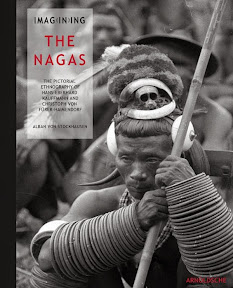Stockhausen: Imag(in)ing the Nagas
Stockhausen, Alban von:
Imag(in)ing the Nagas : the pictorial ethnography of Hans-Eberhard Kauffmann and Christoph von Fürer-Haimendorf / Alban von Stockhausen. [English language copy ed.: Malcolm Green]. - Stuttgart : Arnoldsche Art Publ., 2014. - 452 S. : zahlr. Ill.
Hochschulschrift: Zürich, Univ., Diss., 2011
ISBN 978-3-89790-412-5
EUR 58,00
DDC: 305.8954
Beschreibung
Als die britische Kolonialmacht im neunzehnten Jahrhundert ihren Einfluss auf die Bergregionen im Grenzgebiet zwischen Indien und Burma ausdehnte, begann für die dort ansässigen Naga-Stämme eine Zeit, in der sich ihre Kulturen grundlegend verändern sollten. Den Gewehren der Eroberer folgten die Dogmen der Missionare, aber auch die Zeichenstifte und Fotoapparate der Dokumentaristen. Deren Bilder und Objekte fanden bald ihren Weg auf die Tische der Salons und in die Museen Europas. Die spektakuläre materielle Kultur mit ihrer eigenwilligen Ästhetik sowie das Faszinosum der Kopfjagd führten dazu, dass die Naga schon bald zum Sinnbild der ‚Edlen Wilden‘ stilisiert wurden. Ihre bildliche Dokumentation fand in den 1930er-Jahren einen Höhepunkt in den Forschungsreisen des österreichischen Völkerkundlers Christoph von Fürer-Haimendorf und seines deutschen Kollegen Hans-Eberhard Kauffmann.
Der verschollen geglaubte, vom Autor wiederentdeckte fotografische Nachlass Kauffmann steht im Zentrum der vorliegenden Publikation. In einer ausführlichen ,bildlichen Ethnographie‘ wird der Versuch unternommen, die ästhetische und kulturelle Realität der Naga in den1930er-Jahren durch die Linse des Ethnographen zu rekonstruieren. Die Fotografien Fürer-Haimendorfs werden – neben anderen Quellen – zur Kontextualisierung herangezogen. In einem ausführlichen Einleitungsteil werden die der Arbeit zu Grunde liegenden Methoden vorgestellt sowie die Biographien und politisch-ideologischen Verflechtungen der beiden Ethnographen analysiert. [Verlagsinformation]
Inhalt
INTRODUCTION. 11
1. PHOTOGRAPHS AS ETHNOGRAPHIC SOURCES. 19
1.1 The Invention of Photography. 20
1.2 The Mechanical Reproduction of Reality. 20
1.3 The Visual is Becoming Suspect. 21
1.4 'Visual Anthropology' and 'Visual Science'. 23
1.5 Reading Photographs - Writing Photographs. 24
2. A METHODOLOGICAL FRAMEWORK FOR THIS STUDY. 27
2.1 The Historical Photographs in the Archives. 27
2.2 The Historical Photographs in the Field. 28
2.3 Taking Photographs as an Anthropologist Today. 32
2.4 Focussing on two Photographers. 33
2.5 Reading and Translating the Picture. 35
2.6 Using Fürer-Haimendorf and Other Sources to Understand Kauffmann. 36
2.7 Choosing the Photographs for this Book and their Form of Presentation. 37
3. A HISTORY OF THE VISUAL REPRESENTATION OF THE NAGAS. 39
3.1 A Brief Historical Account of the Naga Region, its Ethnography and its Images. 40
3.2 The Image of the Nagas during Colonial Times. 47
3.3 The Image of the Nagas in the Post-Colonial Period. 96
3.4 Timeline of Naga Recent History and Visual Representation (fold-out). 106
4. CHRISTOPH VON FÜRER-HAIMENDORF. 111
4.1 Biographical Notes. 112
4.2 The Naga Expedition of 1936/37. 116
4.3 Travels to Naga Areas in 1962 and 1970. 130
4.4 The Fürer-Haimendorf Archive at SOAS. 137
4.5 The Naga Object Collection in Vienna. 143
4.6 Fürer-Haimendorf's Photography of the Naga. 145
5. HANS-EBERHARD KAUFFMANN. 163
5.1 Biographical Notes. 164
5.2 The "German Naga-Expedition" of 1936/37. 173
5.3 The Kauffmann Collection. 199
5.4 The Naga Object Collections at Zurich, Basel, Cologne and Paris. 207
5.5 Kauffmann's Photography of the Naga. 210
6. ANTHROPOLOGY AND THE THIRD REICH. 225
6.1 National Socialist Völkerkunde? 225
6.2 Fürer-Haimendorf's Position. 227
6.3 Kauffmann's Position. 229
7. A PICTORIAL ETHNOGRAPHY THROUGH KAUFFMANN'S IMAGERY. 235
7.1 'Hinterindien' and the Naga Hills. 237
7.2 The Naga Village and its Architecture. 249
7.3 Social Structures and Political Systems. 271
7.4 Status. 283
7.5 Agriculture, Hunting and Trade. 311
7.6 Oral Tradition and Religion. 331
7.7 Arts, Crafts, and Body Decoration. 363
7.8 The Impact of Colonial Rule. 399
8. CLOSING REMARKS. 413
Picture Credits. 419
References. 421
Chronological Index of the Naga Expeditions in 1936/37. 446
Acknowledgements. 452
Autor
ALBAN VON STOCKHAUSEN is currently based in Vienna, Austria. In a research project by the Austrian Science Foundation (FWF), he works as a postDoc researcher at the Department of South Asian, Tibetan and Buddhist Studies (University of Vienna). Homepage; Academia.edu Profile.
Quellen: Arnoldsche Art Publishers; Deutsche Nationalbibliothek; Buchhandel.de; Bookbutler
Bildquelle: Arnoldsche Art Publishers
Bibliographie: [1]

